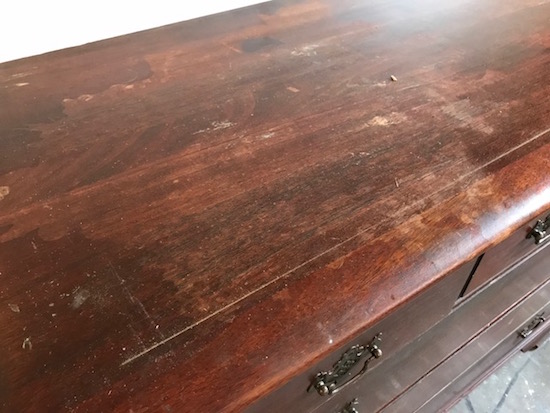The furniture pieces in my home are a mix of modern, rustic, and even shaker-farmhouse. There’s really no one set style, they’re just pieces I happen to love. One thing I’ve always loved though is the surprise of a single, distressed statement piece of furniture mixed in and on display. It’s comforting. These black distressed pieces look as though they’ve been well-used over many years and remind me of home and memories.
When I came across this antique dresser at the local thrift store, I pictured it refinished in a black distressed stain. Stationed in an entryway it would say comfort, family history, and stories.
The challenge was to strip it back to the solid wood that was hiding underneath the worn stain, then send it back many years.
I’ve refinished similar dressers in paint and stain. Once sanded down, though, seeing that the wood was in perfect condition, I was sure stain was the way to go.
I wanted a distressed black stain finish like that you’d find in Pottery Barn. What I love about Pottery Barn furniture is that the finishes are buttery soft with a low lustre sheen and the color looks rubbed off – the way it may naturally distress along the edges after years of people rubbing their hand over the finish.
A combination of Minwax Polyshades stain and a mix of clear wax and a dark wax re-created this look and feel perfectly.
To give you another look at the transformation, take look here where the wood is taken from worn stain, to sanded-back wood, and finally to a time-worn, buttery-soft, hand-rubbed, distressed black.
Polyshades is a stain with the polurethane topcoat built right in. In most instances, you would only need to apply a few coats of the stain/poly mix and be done; but in this case, I applied two coats of the stain and sanded back the poly in-between, then chose to finish it off with the wax.
There are several tricks to applying the stain correctly.
Many people apply stain with a foam brush then wipe the excess off with a rag. Even the instructions on the can suggest this method. After many episodes of trial and error, I now apply all stains with a rag.
Instead, using a rag to apply the stain, you’ll both apply and then remove any excess stain in one step. You’ll have better control as to how much stain you apply and how you distribute it over the wood. Using a rag also eliminates the bubbles you get when you apply Polyshades with a brush.
[Remember to always properly dispose of brushes and rags according to the manufacturer’s instructions as they warn that they can be combustible.]
So after applying the second coat of stain with a rag to this dresser, I sanded it back to let the warm orange shades of the wood pop through.
The wax was applied with a round wax brush and then buffed to a low lustre shine using THIS type of brush [I dare you not to smile when you see the type of brush I use to bring this up to to a really nice shine!}
The depth of colors showing through from the distressing is so convincing that you’re encouraged to walk up to the dresser and run your hand over it only to find a smooth satin finish. I still do this every time I walk by this dresser.
I had a few of these oil-rubbed bronze knobs in my stock. Unfortunately I only had a few and couldn’t find them online, so decided to photograph the dresser with a few of the original handles which I spray painted a matte black. The result is actually a perfect mix of new and old.
This black stained and distressed dresser is now for sale in Entri Ways’ online Shop.
Disclosure: This post contains affiliate links to products I use myself.














It looks so buttery soft that I feel like I can reach out and almost touch it. Beautifully done.
Thank you. It is buttery soft Mary. One of the benefits of wax.
This one is a great to know. I love this look.
Thank you